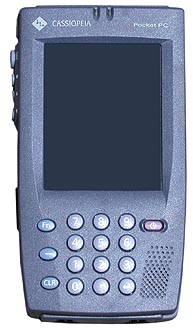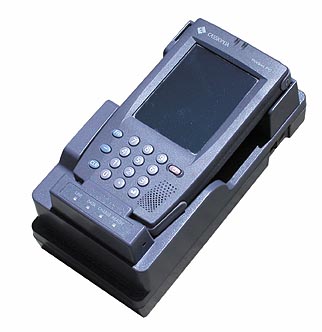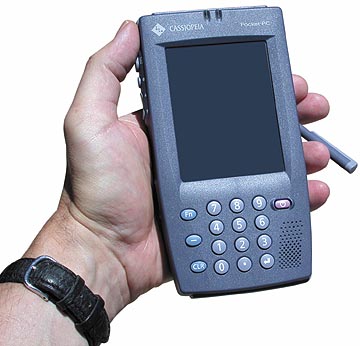|
Casio IT-700
The industrial Cassiopeia (July 2001)
(by Conrad H. Blickenstorfer)
 Casio calls the IT-70/700 line their "industrial
Cassiopeias." The term "industrial" generally implies a no nonsense tool for a
job, one that professionals would use. Professionals want "industrial design"
where form follows function, and "industrial strength" because their livelihood
depends on their tools. With many products, there is a considerable difference
between consumer and industrial versions. Consumer products are generally
designed to be appealing to the eye and have lots of features that move them from
the shelves. Industrial products simply must do the job. They may not look as
fancy and often they have fewer features. That's certainly the case with mobile
technology. Consumer products aim to look as cool and attractive as possible.
Just think of the Palm V or the Handspring Visor Edge or the Compaq iPAQ.
Industrial terminals must be tough and functional, but they often have slower
processors and monochrome screens. What if you could have the best of both
worlds? Combining state-of-the-art consumer electronics with "industrial"
durability and design is an idea whose time has come. It worked for Fujitsu where
notebook technology and industrial design merged into the Stylistic line of pen
tablets, or for Panasonic whose Toughbooks are state-of-the-art notebooks in
handsome, rugged shells. Casio is now using the same approach for the IT line of
industrial Pocket PCs. They combine Casio's consumer electronics know-how and
componentry with no-nonsense industrial design. Casio calls the IT-70/700 line their "industrial
Cassiopeias." The term "industrial" generally implies a no nonsense tool for a
job, one that professionals would use. Professionals want "industrial design"
where form follows function, and "industrial strength" because their livelihood
depends on their tools. With many products, there is a considerable difference
between consumer and industrial versions. Consumer products are generally
designed to be appealing to the eye and have lots of features that move them from
the shelves. Industrial products simply must do the job. They may not look as
fancy and often they have fewer features. That's certainly the case with mobile
technology. Consumer products aim to look as cool and attractive as possible.
Just think of the Palm V or the Handspring Visor Edge or the Compaq iPAQ.
Industrial terminals must be tough and functional, but they often have slower
processors and monochrome screens. What if you could have the best of both
worlds? Combining state-of-the-art consumer electronics with "industrial"
durability and design is an idea whose time has come. It worked for Fujitsu where
notebook technology and industrial design merged into the Stylistic line of pen
tablets, or for Panasonic whose Toughbooks are state-of-the-art notebooks in
handsome, rugged shells. Casio is now using the same approach for the IT line of
industrial Pocket PCs. They combine Casio's consumer electronics know-how and
componentry with no-nonsense industrial design.
When you buy an IT-700, for example, you get all the great multimedia features of
the landmark E-115/125 series of Pocket PCs. It's as if Casio somehow managed to
put the dazzling looks and features of a Porsche into the tough, utilitarian body
of a Land Rover without giving up any of the sportscar's performance. The IT-700
has the same gorgeous 64k color TFT that makes Casio's consumer Pocket PCs
best-of-class for indoor display of images, video clips and overall clarity and
quality. And although standard TFTs generally wash out outdoors and especially in
direct sunlight, a special anti-reflective coating provides enough readability
for operation even in direct sunlight. If you intend to use your device outdoors
most or all of the time, of course, a TFT is not the best answer and you will
want to consider the IT-700's monochrome brother, the IT-70. It uses the same
electronics, but has a FSTN Liquid Crystal, 4-grayscale reflective display that
is optimized for outdoor use.
In terms of performance, the IT-700 shares the E-125 and EM-500's 150MHz version
of NEC's VR4122 RISC processor. That chip is a spritely performer, not quite in
the 206 MHz StrongARM's class when it comes to benchmark performance, but
offering nearly the same day-to-day responsiveness and perhaps the smoothest
digitizer action of all Pocket PCs. Of course, more speed is always better, and
we hope to see the NEC VR4131 that Casio uses in its all-new BE-300 in a next
generation IT device.
 The IT-700 also shares other specifications with Casio's consumer products. It
comes with a generous 32MB of RAM, and also a 16MB "FlashDisk" for custom
applications. Unlike most other industrial Pocket PC products, the IT series
arrives with the full standard complement of Windows CE 3.0 Pocket PC
applications: whatever you get on a Casio E-125 you have on the IT-700, and that
includes the Windows Media Player, Microsoft Reader and Money, and everything
else that comes on consumer Pocket PCs or the accompanying ActiveSync 3.1 CD.
There's a stereo output jack which means that on your next flight to a utilities
conference you could plug in a set of noise canceling headphones (I use Sony's
awesome, yet affordable MDR-NC5 model) headphones and treat yourself to hours of
CD-quality MP3 music. I say "hours" because, like the Casio E-125, the IT-700 has
a Type II CF Card slot, ready to accept one of those new monster RAM cards from
Simple, SanDisk, Delkin or Lexar. And like a consumer Pocket PC, you can record
voice notes on the IT-700 or use it to play games. The IT-700 also shares other specifications with Casio's consumer products. It
comes with a generous 32MB of RAM, and also a 16MB "FlashDisk" for custom
applications. Unlike most other industrial Pocket PC products, the IT series
arrives with the full standard complement of Windows CE 3.0 Pocket PC
applications: whatever you get on a Casio E-125 you have on the IT-700, and that
includes the Windows Media Player, Microsoft Reader and Money, and everything
else that comes on consumer Pocket PCs or the accompanying ActiveSync 3.1 CD.
There's a stereo output jack which means that on your next flight to a utilities
conference you could plug in a set of noise canceling headphones (I use Sony's
awesome, yet affordable MDR-NC5 model) headphones and treat yourself to hours of
CD-quality MP3 music. I say "hours" because, like the Casio E-125, the IT-700 has
a Type II CF Card slot, ready to accept one of those new monster RAM cards from
Simple, SanDisk, Delkin or Lexar. And like a consumer Pocket PC, you can record
voice notes on the IT-700 or use it to play games.
Playing games, of course, won't likely be on an IT-700 user's mind. After all,
this is a industrial device and it shows. All that powerful multimedia hardware
is housed in a body that's very much different from the shiny, smartly designed
consumer Cassiopeias. The IT models are larger and heavier. They are housed in a
tough plastic body that can take some punishment. We're not talking full
ruggedness here, but the ITs can survive multiple drops from 2.5 to over three
feet depending on which screen you use. They are also water resistant, have a
wider operating temperature range than their civilian counterparts, and are
generally fit for use in a variety of sales force, field force automation, and
shop floor environments. We'd compare the relative degree of toughness of the IT
line to that of Fujitsu's Stylistics: tough enough to take some abuse, but not
meant to be used in truly harsh environments.
 The IT line's larger bodies do not only afford enhanced ruggedness, they also
provide additional functionality. There is, for example, a programmable 16-key
keypad for rapid data entry and other functionality. There is also a second
internal CF Card slot that can be used for memory expansion. In the RF versions
of the IT line, that slot is taken up by a internal 802.11b Spread Spectrum
wireless LAN card. The external CD Card slot is positioned so that you can insert
an optional bar code laser scanner. Casio also made some good choices in the
power supply department. Since industrial terminals are expected to last through
a full eight hour shift, there is a long-life battery option that comes complete
with a special battery compartment cover (see picture). Our review unit came with
that battery which provides a whopping 3,100 mAH (compare that with 950 mAH in an
iPAQ). This battery adds less than half an inch to the thickness of the IT. Don't
get yours without it. The backup battery, by the way, keeps your data safe for up
to four days even without any power from the main cell. The IT line's larger bodies do not only afford enhanced ruggedness, they also
provide additional functionality. There is, for example, a programmable 16-key
keypad for rapid data entry and other functionality. There is also a second
internal CF Card slot that can be used for memory expansion. In the RF versions
of the IT line, that slot is taken up by a internal 802.11b Spread Spectrum
wireless LAN card. The external CD Card slot is positioned so that you can insert
an optional bar code laser scanner. Casio also made some good choices in the
power supply department. Since industrial terminals are expected to last through
a full eight hour shift, there is a long-life battery option that comes complete
with a special battery compartment cover (see picture). Our review unit came with
that battery which provides a whopping 3,100 mAH (compare that with 950 mAH in an
iPAQ). This battery adds less than half an inch to the thickness of the IT. Don't
get yours without it. The backup battery, by the way, keeps your data safe for up
to four days even without any power from the main cell.
Being an industrial device, the IT does depart from consumer electronics design
in a few other areas. For example, it is clearly designed to be used in
conjunction with its dock and charging station. There are two versions, one that
is primarily for charging (the IT series does not have an on-board power jack)
and one that provides charging and PC connectivity. There is a serial connector
on the side for use with a cellphone or to connect to a PC. The IrDA 1.1 port is
on the left side and can be used to sync with a notebook. The IT also uses that
port for communication with its dock.
Gripes? The audio record button sticks out too much. Immediately reprogram it to
do something else, such as bringing up the main menu, or else you'll fill the
device with inadvertent recordings of random noise. For those times when the dock
isn't handy, I'd have liked to see a power jack. And an industrial device should
have a screen lid for protection.
In terms of documentation, the IT comes with the standard complement of Microsoft
manuals/CD, and also a good manual dedicated to the IT series. However, once you
get into the more "industrial" aspects of the IT, you'll need to download drivers
and documentation from Casio's website and things can quickly become technical.
 Our review unit, for example, was the RF version of the IT-700. Installing the
802.11 driver and application required a good deal of manual copying and not
everything was entirely clear, but we got it to work. Since we have an 802.11b
wireless network in our editorial office, we could give the RF version a good
workout and it passed with flying colors. We especially appreciated the "Site
Survey Tool" that shows signal strength and beacons received as two bars. Casio
claims a range of up to 300 feet and a typical operating range of 80 feet. It is
at least that. It's just terrific to be able to walk around the office (or a shop
floor) being able to get email in a flash and even look up data from a website. Our review unit, for example, was the RF version of the IT-700. Installing the
802.11 driver and application required a good deal of manual copying and not
everything was entirely clear, but we got it to work. Since we have an 802.11b
wireless network in our editorial office, we could give the RF version a good
workout and it passed with flying colors. We especially appreciated the "Site
Survey Tool" that shows signal strength and beacons received as two bars. Casio
claims a range of up to 300 feet and a typical operating range of 80 feet. It is
at least that. It's just terrific to be able to walk around the office (or a shop
floor) being able to get email in a flash and even look up data from a website.
In many respects, the IT-700 represents the best of two worlds, combining
consumer electronics features with a good degree of ruggedness and industrial
design. The fact that you can get it with a color or grayscale screen, and with
or without wireless LAN, adds to the appeal. -
Comments/Questions?
– Conrad Blickenstorfer
| Processor |
NEC VR4122, 150MHz |
| OS |
Windows CE 3.0 |
| Memory |
32MB RAM, 16MB ROM, 16MB Flash |
| Display |
64k color TFT LCD |
| Digitizer |
Pressure-sensitive panel |
| Storage |
Internal RAM, 2 Type II CF Card slots |
| Size |
3.5 x 6.5 x 1.1 inches |
| Weight |
11.7 oz |
| Power |
3,100mAH Li-Ion (extended pack) |
| Interface |
Serial, Irda 1.1, dock |
| Options |
laser scanner card, chargers, comms unit |
| Price |
IT70/700: NA/US$1,553 (US$1,654/1,953 with 802.11b wireless) |
| Contact |
Casio www.casio.com/personalpcs |
|



